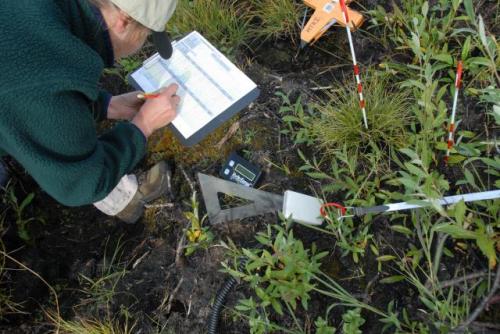The overall goal of this project is to investigate the influence of climate change in the Arctic on fire occurrence and fire effects in the tundra ecoregions of North America (NA). In particular, if fire increases in landscapes where fire is neither currently nor historically of great importance, what impacts will this have on the ecosystem services? Specific objectives of the proposed project are driven by the following two hypotheses:
A: Climate change in the north is causing a fundamental change in fire regime in tundra ecosystems marked by fires of larger size and duration than previously occurred within the last century, leading to increased tundra area burned with higher burn severity.
B: A change in fire regime will adversely influence ecosystem services, including surface hydrology, carbon sequestration, air quality, and wildlife resources, and enhance the feedback to the climate system through increases in surface albedo and release of greenhouse gas.
Our current understanding of arctic fire regimes for the recent and historic past (within the last 50 to 100 years) is poor. Current satellite-based methods for mapping fire at northern latitudes are focused on algorithms tuned to forested landscapes rather than treeless tundra types. Therefore, our current accounting of recent fire for the circumpolar arctic is not complete. Fire regime is also most likely changing, and will be changing quickly since fire is strongly driven by climate, and climate is changing fast in the arctic. Current ability to predict future fire occurrence in the face of climate change is maturing, and has the potential to improve understanding of the magnitude of fire change. Within this project we will improve maps of past fire using remote sensing-based resources (AVHRR, MODIS, and Landsat) using established techniques for fire mapping but “tuned” to detect fires in treeless, Arctic landscapes. Surface conditions following fire and post-fire vegetation dynamics will be assessed in the field and from remote sensing. We will use the acquired knowledge to drive a fire occurrence model fine-tuned to ecosystem specifics of Arctic NA. We also plan to apply existing climate models within a framework of fire occurrence modeling to develop future fire occurrence scenarios. We will use the fire regime information for the past to learn the possible implications of climate change-induced fire regime change. Influences of particular interest are related to impacts on systems specifically vulnerable to climate change and/or disturbance. The factors we will investigate are: 1) changes to surface hydrology, which influences vegetation regrowth; 2) implications for carbon cycling and sequestration, including the immediate release of pyrogenic carbon;
3) influences on energy balance, both the release of radiatively important CO2, CH4, and aerosols, and changes to surface albedo; and 4) impacts to wildlife land use, such as caribou forage conditions.


